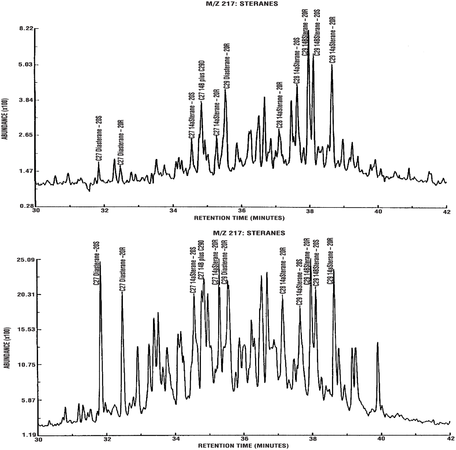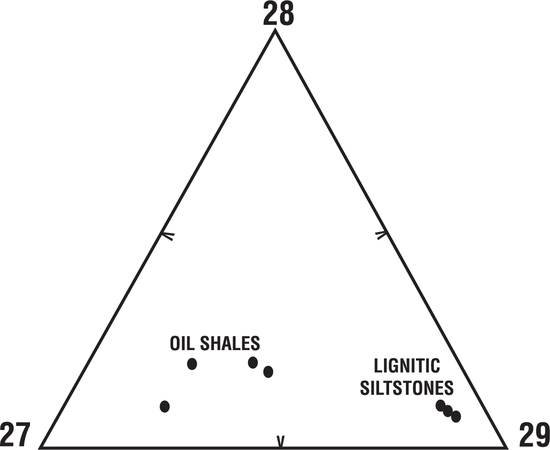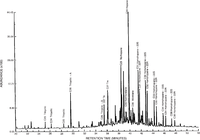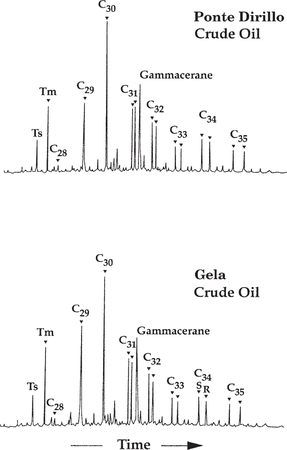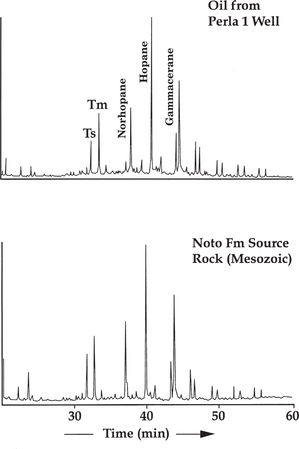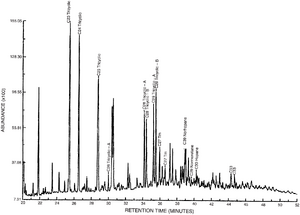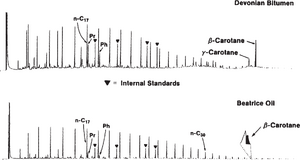Organic compounds: environmental indicators
| Exploring for Oil and Gas Traps | |

| |
| Series | Treatise in Petroleum Geology |
|---|---|
| Part | Critical elements of the petroleum system |
| Chapter | Oil–oil and oil–source rock correlations |
| Author | Douglas W. Waples, Joseph A. Curiale |
| Link | Web page |
| Store | AAPG Store |
Some organic compounds are associated with certain environments.
Steranes
Figure 2 Ternary diagram, a convenient and common way of displaying basic data on sterane distributions. From Palmer;[1] reprinted with permission from Rocky Mountain Assoc. of Geologists.
The relative amounts of C27, C28 and C29 steranes in oils are controlled by the types of photosynthetic organisms that contributed to the organic matter. A dominance of C27 steranes is almost always associated with marine organisms. Most nonmarine organic matter has a dominance of the C29 sterane precursors, but C29 steranes can dominate in marine systems as well. The abundance of C28 steranes in marine systems may depend primarily on geologic age[2] but this idea is controversial. In nonmarine systems, there is no proposed relationship between C28 sterane abundance and age. C30 steranes (n-propylcholestanes) are usually less abundant than the other regular steranes and occur only in samples deposited where marine organisms lived.[3]
Figure 1 shows m/z 217 mass fragmentograms from two oils showing quite different distributions of regular steranes. The top example is dominated by C29 steranes with only moderate amounts of C27 and C28. The bottom sample, in contrast, shows similar amounts of all three homologs plus moderate amounts of the C30 steranes (four unlabeled peaks to the far right).
Figure 2 shows a ternary diagram, a convenient and common way of displaying basic data on sterane distributions. This example shows the relative proportions of the C27, C28, and C29 regular steranes for several extracts from two distinct facies within the nonmarine Elko Formation (Eocene/Oligocene) of Nevada. The lignitic siltstones are dominated by terrestrial plant material, whereas the oil shales are made up of lacustrine algae.
4-methylsteranes
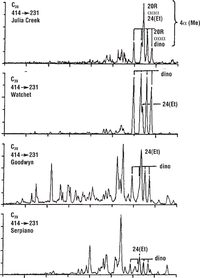
MRM analysis is useful in distinguishing n-propylcholestanes from 4-methylsteranes and in assigning identities to different types of 4-methylsteranes. This sophisticated GC/MS analysis method will probably become commonplace because of its specificity in oil–oil and oil–source rock correlation efforts.
Figure 3 shows the distribution of 4-methylsteranes in selected rock extracts. The 414 → 231 metastable ion transition shows C30 steranes methylated on the A-ring. Two major families are shown here. The dinosteranes (derived from dinoflagellates) are designated “dino,” whereas another group of 4-methylsteranes with an ethyl group at the 24 position are designated “24(Et).”
Diasteranes
Diasteranes are mainly associated with clastic environments, and they increase in relative abundance with increasing maturity. However, they are also known from nonclastic samples and can, in some cases, be abundant even in low-maturity samples.
Figure 1 shows two distinct distributions of diasteranes. The top oil has very few diasteranes, indicating a possible lack of clay in the source rock. The bottom oil, in contrast, has similar amounts of diasteranes and regular steranes and probably comes from a clastic source.
Hopanes
Hopanes, which originate from bacteria, are the most abundant triterpanes. A distribution with a regular decrease of homohopanes from C31 to C35 is thought to be associated with clastic environments.[5] and/or more oxidizing conditions[6]
Figure 4 shows the m/z 191 mass fragmentogram of an oil displaying the most common type of homohopane distribution.
Irregular homohopanes

Irregular distributions of the C32–C35 homohopanes are associated with carbonates[5] and/or more reducing conditions.[6] Unusually large amounts of the C31 homohopanes are sometimes associated with coals and coaly material.[5]
Figure 5 shows m/z 191 mass chromatograms for two sediment extracts from the Brac-1 well (Croatia) showing irregular homohopane distributions [relative enhancement of the C35 species (left) and C34 species (right). We would expect the oils sourced from these sediments to show these same characteristics.
Gammacerane
Figure 6 Gammacerane in the m/z 191 mass chromatograms of two genetically related oils from southern Sicily. From Ocampo et al.;[8] reprinted with permission from American Chemical Society.
Figure 7 Samples with gammacerane, but in this case gammacerane essentially coelutes with the C31-22R epimer. From Mattavelli and Novelli;[9] reprinted with permission from AAPG.
In addition to the hopane family, several other types of triterpanes that are occasionally encountered can be very useful in correlations. Gammacerane is often found in sediments deposited under abnormal salinites, including lacustrine facies. Identification of gammacerane can be difficult, however, both because it is usually only a minor component and because it elutes at different places with different chromatographic columns.
Figure 6 shows gammacerane in the m/z 191 mass chromatograms of two genetically related oils from southern Sicily. In this example, gammacerane elutes after the C31 homohopanes. Note also the relative increase in the C34 and C35 homohopanes. The presence of gammacerane and the homohopane distribution suggest a strongly reducing, possibly carbonate or hypersaline depositional setting for the source rock of these oils.
Figure 7 also shows samples with gammacerane, but in this case gammacerane essentially coelutes with the C31-22R epimer. This example shows an oil from the Perla-1 well in southern Sicily and a source rock extract from the Noto Formation that correlates with it almost exactly.
Oleananes
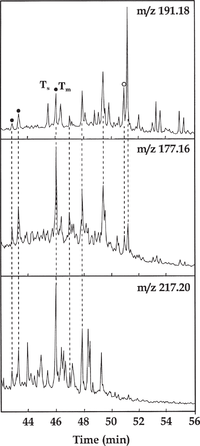
Oleanane (two major isomers exist) originates from terrestrial flowering plants of Late Cretaceous or, more commonly, Tertiary age and as such is very valuable in correlation problems when deciding whether an oil comes from a source rock that is young or old.[11]
Figure 8 shows three mass chromatograms (m/z 191.18, 177.16, and 217.20, from top to bottom) for an oil from central Myanmar. The peak marked “o” is a combination of 18α(H) and 18β(H) oleanane. The tallest peak in the m/z 191 mass chromatogram is hopane, and the peaks indicated by solid dots are bicadinanes.
Bicadinanes
Bicadinanes are among the very few compounds that give substantial peaks in both the m/z 191 and 217 fragment ions. Bicadinane resins are derived from terrestrial plants that evolved in the Tertiary. The primary source plants, dipterocarps, spread slowly through Southeast Asia during the middle to late Tertiary. Bicadinanes are rare in other places and at other times, except from the Tertiary of New Zealand and Australia, where they probably originated from other species.[12] Bicadinanes are often found together with oleanane.
Figure 8 shows bicadinanes in an oil sample from Myanmar. Note that the bicadinane peaks (indicated by solid dots) appear in all three fragment ions.
Cx and Cz triterpanes
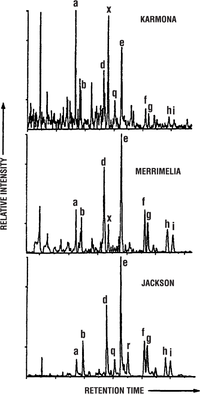
Two triterpanes, often called “Cz” and “Cx,” are also empirically associated with terrestrial organic matter, but their origin is unknown. They can be seen in Figure 4. Cz has also been called compound X[13] and has been shown to be a diahopane.[6] Cx is probably a neohopane. They often co-occur with other terrestrial markers, such as high C29 steranes, oleanane, and bicadinanes, but they can also occur alone.
Figure 9 shows m/z 191 mass chromatograms of three oils from the Cooper/Eromanga basin of Australia. The highest relative concentrations of Cz and Cx occur in the oil that appears to have the lowest absolute concentration of other triterpanes (Karmona), as judged by the greatest amount of noise in the baseline. Cz and Cx (unlabelled but visible to the left of peak “b” in the Karmona sample) are probably more resistant to thermal destruction, and thus increase in relative concentration as other triterpanes are destroyed at high levels of maturity.[5] Cx often coelutes with Tm (peak “b” in this figure).
28,30-bisnorhopane
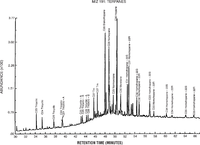
Sometimes in great abundance, 28,30-bisnorhopane has been found in a few important source rocks and related oils (Monterey Formation, Kimmeridge Clay). It is probably of microbial origin. Because bisnorhopane is most common in sulfur-rich environments, its origin may have to do with bacteria that participate in the sulfur cycle. Denis Miiller (personal communication, 1994) notes that in the Monterey oils of southern California, bisnorhopane contents are proportional to sulfur contents.
Figure 10 shows the m/z 191 mass fragmentogram of an oil with a high relative concentration of 28,30-bisnorhopane, eluting to the left of norhopane (C29 hopane).
Tricyclic terpanes
Certain tricyclic terpanes, probably derived from bacteria, Tasmanites, or both, are ubiquitous. In most facies they are less abundant than pentacyclic triterpanes such as hopanes but in some cases are dominant. However, because these tricyclics appear to be more stable, tricyclic/pentacyclic ratios also seem to be influenced by maturity, and thus may not always be reliable for correlations. The distribution of individual tricyclics and tetracyclics may also be used for correlation—especially for carbonates, where the tetracyclics are most abundant.
Figure 11 shows the m/z 191 fragmentogram for an unusual oil in which the tricyclic terpanes (left side of the chromatogram) strongly dominate the pentacyclics.
Diterpanes
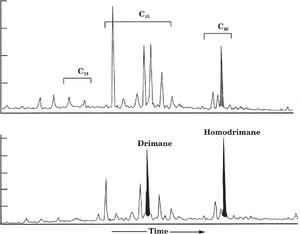
Other diterpane and sesquiterpane distributions are also used for correlations. Most diterpanes originate from terrestrial resins, but microbial sources are also known.[6] Sesquiterpanes derive primarily from terrestrial plant resins. Most resin-derived compounds are of Tertiary or possibly Late Cretaceous age.
Figure 12 shows m/z 123 mass chromatograms of two oils from northeast China. The differing sesquiterpane distributions show that the oils are not derived from the same source rock facies.
Carotanes
Carotanes—hydrocarbons derived from photosynthetic organisms and associated with anoxic marine and lacustrine facies—are also used as oil–oil and oil–source rock correlation parameters. Peters et al.[15] used the occurrence of β-carotane in Devonian rocks (of the U.K. offshore) to suggest a Devonian input to the source composition of the Beatrice oil. These compounds are particularly useful in hypersaline settings. Lacustrine and marine facies containing carotanes can often be distinguished by other indicators, such as the presence of 4-methylsteranes and pristane-phytane ratios less than 1.0 for lacustrine facies.
Unfortunately many analyses overlook carotanes because these high-molecular-weight compounds elute very late on gas Chromatograph columns. To obtain this information, you may have to make special arrangements prior to analysis. Thus, the absence of carotanes in chromatograms may simply indicate that they were not looked for, rather than that they are truly absent.
Figure 13 shows that carotanes are sometimes so abundant that they can be analyzed using gas chromatography (More definitive identification and analysis of samples in which carotanes are less abundant can be done using GC/MS.) The gas chromatograms are of the Beatrice Field oil in the Moray Firth (U.K.) and of the extract of a Devonian rock believed to be one of the source contributors.
Summary of application of GC/MS to correlation studies
The following table summarizes the application of GC/MS to correlation studies.
| This class of compound … | May indicate an origin of … |
|---|---|
| C27 steranes | Marine organisms (minor amounts occur in nonmarine organisms) |
| C29 steranes | Marine or nonmarine organic matter |
| C30 steranes | Marine or lacustrine organisms |
| Diasteranes | Clastic environment |
| Hopanes | Bacteria |
| Gammacerane | Abnormal salinites |
| Oleanane | Late Cretaceous or Tertiary terrestrial flowering plants |
| Bicadinanes | Tertiary terrestrial plants |
| Cz and Cx triterpanes | Terrestrial organic matter or environment |
| 28,30-bisnorhopane | Microbes |
| Tricyclic terpanes | Bacteria or Tasmanites |
| Diterpanes | Terrestrial resins or microbes |
| Sesquiterpanes | Terrestrial plant resins |
| Carotanes | Anoxic marine or lacustrine environment |
See also
- Molecular parameter data for oil–oil and oil–source rock correlations
- Gas chromatography: data obtained
- Gas chromatography/mass spectrometry (GC/MS): procedures
- Gas chromatography/mass spectrometry (GC/MS): examples of correlations
- Gas chromatography/mass spectrometry (GC/MS): limitations
- High-performance liquid chromatography
References
- ↑ Palmer, S. E., 1984, Hydrocarbon source potential of organic facies of the lacustrine Elko Formation (Eocene/Oligocene), northeast Nevada, in J. Woodward, F. F. Meissner, and J. L. Clayton, eds., Hydrocarbon source rocks of the greater Rocky Mountain region: Denver, Rocky Mountain Association of Geologists, p. 491–511.
- ↑ Grantham, P. J., and L. L. Wakefield, 1988, Variations in the sterane carbon number distributions of marine source rock derived crude oils through geological time: Organic Geochemistry, vol. 12, p. 61–73, DOI: 10.1016/0146-6380(88)90115-5.
- ↑ Moldowan, J. M., W. K. Seifert, and E. J. Gallegos, 1985, Relationship between petroleum composition and depositional environment of petroleum source rocks: AAPG Bulletin, vol. 69, p. 1255–1268.
- ↑ Summons, R. E., J. Thomas, J. R. Maxwell, and C. J. Boreham, 1992, Secular and environmental constraints on the occurrence of dinosteranes in sediments: Geochimica et Cosmochimica Acta, vol. 56, p. 2437–2444, DOI: 10.1016/0016-7037(92)90200-3.
- ↑ 5.0 5.1 5.2 5.3 Waples, D. W., and T. Machihara, 1991, Biomarkers for geologists: AAPG Methods in Exploration 9, 91 p.
- ↑ 6.0 6.1 6.2 6.3 Peters, K. E., and J. M. Moldowan, 1993, The Biomarker Guide—Interpreting Molecular fossils in Petroleum and Ancient Sediments: Englewood Cliffs, New Jersey, Prentice-Hall, 363 p.
- ↑ Moldowan, J. M., C. Y. Lee, P. Sundararaman, T. Salvatori, A. Alajbeg, B. Gjukic, G. J. Demaison, N.-E. Slougue, and D. S. Watt, 1992, Source correlation and maturity assessment of select oils and rocks from the central Adriatic Basin (Italy and Yugoslavia), in J. M. Moldowan, P. Albrecht, and R. P. Philp, eds., Biological markers in sediments and petroleum: Englewood Cliffs, New Jersey, Prentice-Hall, 411 p.
- ↑ Ocampo, R., A. Riva, J. M. Trendel, J. Riolo, H. J. Callot, and P. Albrecht, 1993, Petroporphyrins as biomarkers in oil-oil and oil-source rock correlations: Energy & Fuels, vol. 7, p. 191–193, DOI: 10.1021/ef00038a005
- ↑ Mattavelli, L., and L. Novelli, 1990, Geochemistry and habitat of the oils in Italy: AAPG Bulletin, vol. 74, p. 1623–1639.
- ↑ Curiale, J. A., 1994, Correlation of oils and source rocks—a conceptual and historical perspective, in L. B. Magoon, and W. G. Dow, eds., The Petroleum system—From Source to Trap: AAPG Memoir 60, p. 251–260.
- ↑ Riva, A., P. G. Caccialanza, and F. Quagliaroli, 1988, Recognition of 18β(H)-oleanane in several crudes and Cainozoic-Upper Cretaceous sediments. Definition of a new maturity parameter: Organic Geochemistry, vol. 13, p. 671–675, DOI: 10.1016/0146-6380(88)90088-5.
- ↑ Murray, A. P., R. E. Summons, J. Bradshaw, and B. Pawih, 1993, Cenozoic oil in Papua New Guinea—evidence from geochemical analysis of two newly discovered seeps, in G. J. Carman, and Z. Carman, eds., Petroleum Exploration and Development in Papua New Guinea: Proceedings of the Second PNG Petroleum Convention, Australian Geological Survey, p. 489–498.
- ↑ 13.0 13.1 Philp, R. P., and T. D. Gilbert, 1986, Biomarker distributions in oils predominantly derived from terrigenous source material, in D. Leythaeuser, and J. Rullkötter, eds., Advances in Organic Geochemistry 1985: New York, Elsevier, p. 73–84.
- ↑ Huang, Y., G. Ansong, F. Jiamo, S. Guoying, Z. Biqiang, C. Yixian, and L. Maofen, 1992, The investigation of characteristics of biomarker assemblages and their precursors in Damintun ultra-high wax oils and related source rocks: Organic Geochemistry, vol. 19, p. 29–39, DOI: 10.1016/0146-6380(92)90025-S.
- ↑ Peters, K. E., J. M. Moldowan, A. R. Driscole, and G. J. Demaison, 1989, Origin of Beatrice oil by co-sourcing from Devonian and Middle Jurassic source rocks, Inner Moray Firth, UK: AAPG Bulletin, vol. 73, p. 454–471.
